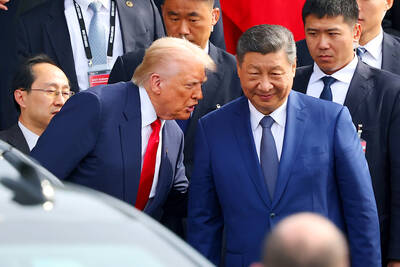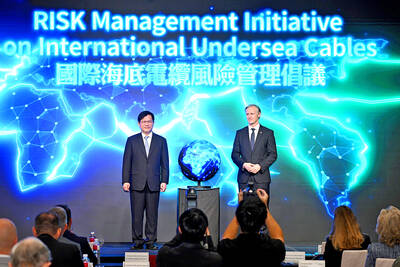The national power supply indicator yesterday signaled “red” for the first time this year and will remain “red” through Friday due to hotter-than-expected weather that has prompted greater power demand, Taiwan Power Co (Taipower, 台電) said.
A “red” alert indicates that the electricity operating reserve has fallen below 900,000 kilowatts (kW), the state-run utility said.
“The mercury rose as high as 38.3? Celsius about noon in Taipei [yesterday], driving electricity demand up more than Taipower’s forecast,” spokesman Lin Te-fu (林德福) told reporters.
The maximum power supply capacity yesterday was 37.01 gigawatts, but after deducting the peak electricity consumption of 36.16 gigawatts at 2:09pm, the nation’s operating reserve was 846,000kW later in the afternoon, Taipower’s data showed.
Taichung Power Plant’s No. 1 generator, which can provide 550,000kW, went back into operation late on Sunday after a broken pipe was fixed, otherwise the power supply indicator would have hit “black” yesterday with only 296,000kW in operating reserve, a Taipower official said.
According to the company’s five-color scale, “black” means the reserve is less than 500,000kW and that the company could initiate electricity rationing.
The electricity contribution from wind farms, solar power and cogeneration units yesterday increased by 300,000kW from the day before, which also helped with power supplies, the official said.
Based on the Central Weather Bureau’s forecast, Taipower said it estimates the maximum power demand today will be 36.2 gigawatts, which would leave an operating reserve of 755,000kW, or a reserve margin of 2.09 percent.
The operating reserve is estimated to be 675,000kW, or a margin of 1.86 percent, tomorrow, Thursday and Friday, Taipower said.
Trial runs this week of a new power generator at a coal-fired power plant in Kaohsiung’s Dalin Township (大林) and one at a gas-fired power plant in Taoyuan’s Datan Township (大潭) could help ease the constrained electricity supply, Lin said.
Taipower pays close attention to the status of all power generators nationwide to prevent any malfunction that might affect the power supply, Lin said.
He declined to say if a generator malfunction could lead to a “black” alert and the possibility of electricity rationing.
Taiwan has experienced electricity rationing 57 times since 1988, the last time in 2002, Taipower’s data showed.
Taipower calls on the public to raise the temperature setting of air-conditioners in the afternoons to help reduce electricity consumption, Lin said.
If rationing starts, it would be implemented based on the standard operating procedure formulated by the Ministry of Economic Affairs, Taipower said.
The procedure stipulates that if a power shortage occurs, the company is to inform heavy users that rationing measures will be put in place the next day.
Taipower would first reduce power supplies by 5 percent to businesses that use more than 5,000kW, followed by a 5 percent reduction to those who use between 1,000kW and 5,000kW if the problem is not resolved.
Rationing would be increased to 10 percent or even 15 percent if the power supply becomes even tighter, it said.
If the power supply remains insufficient, rationing would be imposed on businesses that use less than 1,000kW, as well as households.
Additional reporting by CNA

UKRAINE, NVIDIA: The US leader said the subject of Russia’s war had come up ‘very strongly,’ while Jenson Huang was hoping that the conversation was good Chinese President Xi Jinping (習近平) and US President Donald Trump had differing takes following their meeting in Busan, South Korea, yesterday. Xi said that the two sides should complete follow-up work as soon as possible to deliver tangible results that would provide “peace of mind” to China, the US and the rest of the world, while Trump hailed the “great success” of the talks. The two discussed trade, including a deal to reduce tariffs slapped on China for its role in the fentanyl trade, as well as cooperation in ending the war in Ukraine, among other issues, but they did not mention

Japanese Prime Minister Sanae Takaichi yesterday lavished US President Donald Trump with praise and vows of a “golden age” of ties on his visit to Tokyo, before inking a deal with Washington aimed at securing critical minerals. Takaichi — Japan’s first female prime minister — pulled out all the stops for Trump in her opening test on the international stage and even announced that she would nominate him for a Nobel Peace Prize, the White House said. Trump has become increasingly focused on the Nobel since his return to power in January and claims to have ended several conflicts around the world,

GLOBAL PROJECT: Underseas cables ‘are the nervous system of democratic connectivity,’ which is under stress, Member of the European Parliament Rihards Kols said The government yesterday launched an initiative to promote global cooperation on improved security of undersea cables, following reported disruptions of such cables near Taiwan and around the world. The Management Initiative on International Undersea Cables aims to “bring together stakeholders, align standards, promote best practices and turn shared concerns into beneficial cooperation,” Minister of Foreign Affairs Lin Chia-lung (林佳龍) said at a seminar in Taipei. The project would be known as “RISK,” an acronym for risk mitigation, information sharing, systemic reform and knowledge building, he said at the seminar, titled “Taiwan-Europe Subsea Cable Security Cooperation Forum.” Taiwan sits at a vital junction on

LONG-HELD POSITION: Washington has repeatedly and clearly reiterated its support for Taiwan and its long-term policy, the Ministry of Foreign Affairs said US Secretary of State Marco Rubio yesterday said that Taiwan should not be concerned about being used as a bargaining chip in the ongoing US-China trade talks. “I don’t think you’re going to see some trade deal where, if what people are worried about is, we’re going to get some trade deal or we’re going to get favorable treatment on trade in exchange for walking away from Taiwan,” Rubio told reporters aboard his airplane traveling between Israel and Qatar en route to Asia. “No one is contemplating that,” Reuters quoted Rubio as saying. A US Treasury spokesman yesterday told reporters